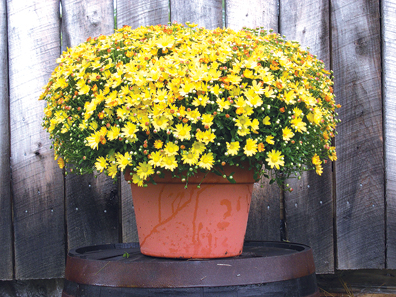
Have you planted hardy mums that never came back the next year?
One secret to success is to buy them before they bloom and plant them right away. The sooner you plant mums the happier they’ll be. Mums that are trapped in a small pot for too long, or allowed to dry out, rarely come back the following year.
If your goal is to have hardy perennial mums, you should treat them as you would any other container-grown flower or vegetable plant.

This is ideal for containers and window boxes. We also recommend mixing Espoma “Flower Tone” Flower Tone, is a slow-release fertilizer that won’t burn, into the soil.
To plant hardy mums in your garden permanently, dig a hole at least 1 foot wide and six inches deep. Mix the dirt from the hole with a generous amount of humus, mushroom compost or peat moss, plus 1/2 cup of Flower Tone.
Make a shallow “bowl” with the soil to trap water around the roots. Cover with several inches of mulch and water thoroughly. For two weeks you must water every day, rain or no rain, about a half-gallon per plant.
Cut off the blooms as soon as they start to fade. You can just shear a few inches off the plant to remove the tips. This will re-direct the plants’ energy to building roots and getting established. Leave the foliage all winter to protect the roots from drying winds. When spring comes, cut the plant to the ground as soon as you see new, green leaves showing around the base.
Pedigree is very important with mums. Mum breeders select for flower color, length of flowering, sturdiness, resistance to disease, and an attractive compact mounding shape.
Like thoroughbred horses and AKC dogs, the best mums have a “family tree” and a catchy name. The best mums are patented and may cost a bit more, but they are clearly superior plants and perform better.
How mums are handled by the grower and retailer directly affects quality, and also how well they adapt as perennials. Cheaper mums are typically grown so close together they don’t develop a nice rounded shape.
If they are allowed to dry out even once, their roots and flower buds become stunted and will never really thrive. Get your mums early in the season before they get “root-bound”, from a grower that really takes good care of their plants. Cheap mums are no bargain.
Getting mums to thrive starts with giving them enough soil. When buying mums check how much soil is in the pot; skimpy soil means poor quality, root-bound plants that will dry out quickly.
The more soil they have to grow in the bigger mums get, and the less often they’ll need watering.
Does all this seem like a lot of trouble? If so, just enjoy your fall mums just as you would a bouquet of cut flowers. This much long-lasting color for so little is a true bargain.
Steve Boehme and his wife Marjorie own GoodSeed Nursery & Landscape, located near Winchester, Ohio at 9736 Tri-County Highway. More information is available at www.goodseedfarm.com or call (937) 587-7021.
